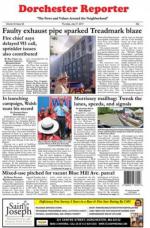July 8, 2010
 Recycling
Recycling
Early last July, the city began to roll out a new single-stream recycling program as part of an effort to improve recycling rates in the City. The single-stream system enabled residents to combine all of their recyclables into one container, a 64-gallon blue, wheeled cart that has become the sign of improving recycling rates throughout the city.
The roll out of the carts was completed this past week, said Jim Hunt III, the city’s chief of environment and energy.
“Charlestown was the final neighborhood to get delivery of carts as part of the mayor’s program,” he said.
Recycling citywide has increased by 29 percent, from 20,000 tons to 26,000 tons, in the past eleven months, Hunt said, which translates to a savings of $480,000 in waste disposal costs. Dorchester doubled its tonnage of recycled materials from 2,257 tons in the first eleven months of fiscal year 2009 to 4,749 tons in the first eleven months of fiscal year 2010.
Numbers from this July are yet to be reported. The curbside recycling rate, however, remained low, at 8 percent. Dorchester sent 51,632 tons of trash to landfills over the last eleven months, Hunt said.
Hunt said that the city has seen increased participation across the board in recycling programs. So much so that his office has received calls from enthusiastic recyclers looking to get their hands on a second bin. Hunt said that those bins are now being made available to residents who would like to request them, which they can do by calling 617-635-4959.
“If there is a resident in Dorchester who is interested in receiving a cart or there is a high recycler, we do now have those available for the first time,” he said.
The increased recycling has also led to cosmetic improvements in many neighborhoods, Hunt said, as the large lidded bins prevent trash from littering streets, sidewalks, and front lawns.
“In my neighborhood in Dorchester, you drive down the street and see the carts out and they’re clean,” Hunt said. “We don’t have materials blowing out of the smaller bins, and it is leading to more uniformity on the curb.”
Peter Buttkus, director of the Duxbury Department of Public Works, said that his city adopted a single-stream recycling system in the fall of 2008. They combined the new recycling system with a pay-as-you-throw trash collection system, however, which he said has proven very effective. Pay-as-you-throw programs charge residents for the trash disposed by unit, a measure that proponents say makes residents more conscious of the costs involved in trash removal. Residents are not charged for recyclables collected.
“In both instances residents were a little hesitant,” Buttkus said, “but we did a lot of public education and we tried to get a lot of media coverage around it. Once people started using it, they loved it. It makes things much easier for people”
Claire Sullivan is the executive director of the South Shore Recycling Cooperative, an organization that works with Duxbury and fourteen others towns and communities to improve their recycling and waste disposal programs. She said that resident apathy and lack of funding, on both the state and town level, are usually the biggest obstacles in the way of successful recycling programs. “It’s a big budget item,” she said. “There are a lot of things they could do to reduce waste.”
Sullivan said that single-stream recycling is effective in some cases, but cannot be the only way a community attempts to address recycling. Single-stream recycling, she said, can also lead to more contamination, lowering the quality of the recycled material.
“The materials that come out of the separating facility have to be usable by the end market,” Sullivan said. “When paper goes through a single-stream process, it goes through with things like little pieces of plastic and shards of glass that don’t get taken out effectively.”
Hunt said that the city considered this problem before implementing the single-stream system, and said that in Boston the benefits of increased recycling rates outweighed the cost of some contamination.
“That’s why we started the pilot neighborhoods,” he said, “and that’s why we wanted to examine if it would drive greater participation and greater tonnage, and how the industry would to respond to it.”
Hunt estimated that the single-stream process has resulted in less than 5 to 7 percent residuals, which he said is very good by industry standards. “Compliance is high, and the amount of material is very high,” he said.
Dorchester residents, for their part, seem to have taken to the new program. Resident Deirdre Manning said she has noticed more people recycling, and in greater quantities.
“I have to say that at least on my street, people are wheeling out those carts, and they’re packed to the brim,” she said. Some residents are more knowledgeable about recycling than others, she said, but she thinks that could be improved by education and outreach.
Charles Tuttle, a Dorchester resident who is an environmental analyst in the Massachusetts Department of Energy Resources, said that he has noticed an uptick in both his own and his neighbors’ recycling habits. Tuttle said that sometimes the recycling divide is a generational one – younger residents are more likely to have learned about recycling in school. “I think the older generation is just not aware of it as much,” he said.
Hunt said that there are some simple measures residents can take to improve their neighborhood’s recycling rates.
“One of the things we’re seeing is a lot of plastic bags that you receive at Stop and Shop and other places. Those should not go in recycling,” Hunt said. “They can also look to compost their leaf and yard waste at their home.”



